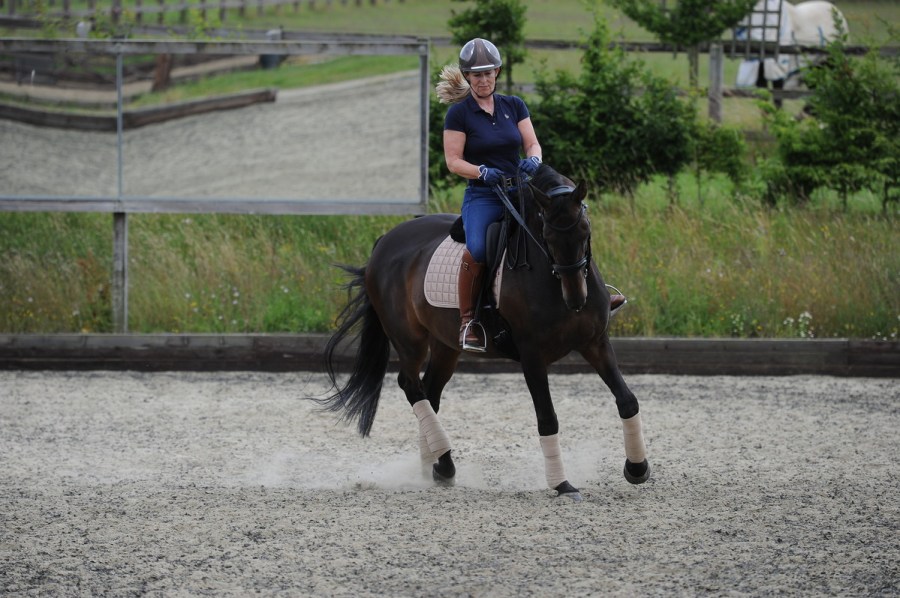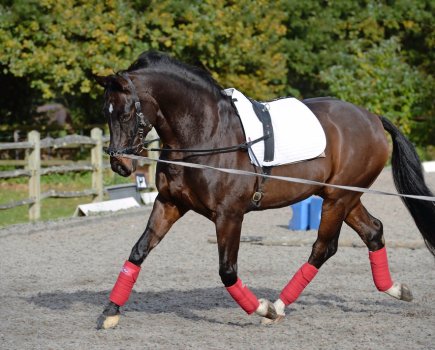Suppleness through the body is essential for working correctly, economically and to the best of your horse’s ability, says event rider Victoria Bax.
Your horse can never be too supple and, therefore, you can never do too many suppling exercises with them. Being able to isolate which parts of the body to keep supple, while the rest of the body stays stable, is a great skill to have and will help in all training, but particularly when performing more technical movements.
The ability to be flexible in all paces is required in dressage tests at all levels, but is especially key in the canter when it comes to showjumping and cross-country.
Working on transitions within the pace is important too. When you collect the pace, you encourage your horse to accept more of their bodyweight on their hindlegs. This strengthens the frame and lightens the forehand – something every rider should work towards.
In the same way, when you increase your horse’s stride length, they are encouraged to step through with a bigger stride and carry their weight on their hind end, rather than fall onto their forehand.
Exercise 1
Time: 5 minutes
Flexing the head and neck will help your horse to open up the spinal processes and flex their back, helping them to relax and increase the range of movement through their spine.
This exercise can be done in walk, trot or canter, depending on you and your horse’s level of ability.
How to ride it:
- Ride down the long side of the arena while gently flexing your horse’s head and neck to the inside and outside. Ensure the main part of their body stays in a straight line.
- Maintain a balanced body position and keep looking forwards in the direction of travel, not down at their head. Keep an even feel along both reins.
- When your horse’s neck is flexed to the inside, use your outside rein as a support to stop them falling to the inside as they follow the direction of bend. Move your inside leg forwards a little to stop their shoulder falling in too. Similarly, when their neck is flexed to the outside, your inside rein becomes the supporting rein. This time move your outside leg slightly forwards to stop them falling to the outside.
Exercise 2
Time: 15 minutes
This exercise is great for developing the suppleness and flexibility through the whole of your horse’s body. As before, the exercise can be done in walk, trot or canter.
- As you go round the corner from the short side of the arena to the long side, change the bend and flex your horse’s head and neck to the outside. Then, with your outside leg just slightly behind the girth, push their body towards the inside.
- Support with your other leg as you only want your horse to move a few steps on the inside before you position them straight again using the inside rein. Now change the bend completely and return to an inside flexion.
- Use your inside leg slightly behind the girth to move your horse back to the track, then straighten up again and ride the corner correctly to finish. Ensure you look in the direction of travel, but that your horse looks slightly away from the direction of travel.
- Change the rein and repeat.
Exercise 3
Time: 10 minutes
Working on transitions within the pace helps your horse learn to sit and become more supple in their hindquarters and hocks. This exercise can be done in walk, trot or canter.
- On a 20m circle, move both your legs forwards slightly, in front of the girth, to encourage your horse to take a bigger step. Here, you’re aiming towards working in medium paces.
- Maintain your body position and engage your core to ensure you don’t tip forwards as their stride lengthens.
- Hold the bigger steps for a few strides, then return your legs to their normal position on the girth.
- Now move both your legs slightly back, fractionally behind the girth, sit up taller, push your weight down into your stirrups (not the saddle) and use small half-halts (squeezes of the rein) to bring your horse back to smaller steps again. Here, you’re aiming to work in more collected paces.
- Repeat on the other rein.
Meet the expert: Victoria Bax is a UKCC Level 2 British Eventing accredited coach, 2* event rider and trainer with a special skill in retraining ex-racehorses.









